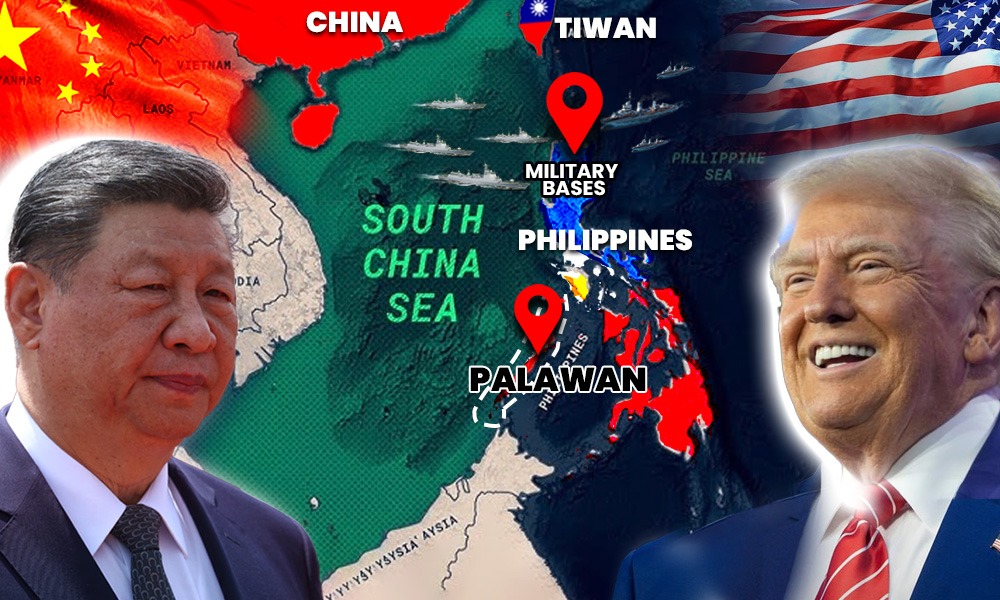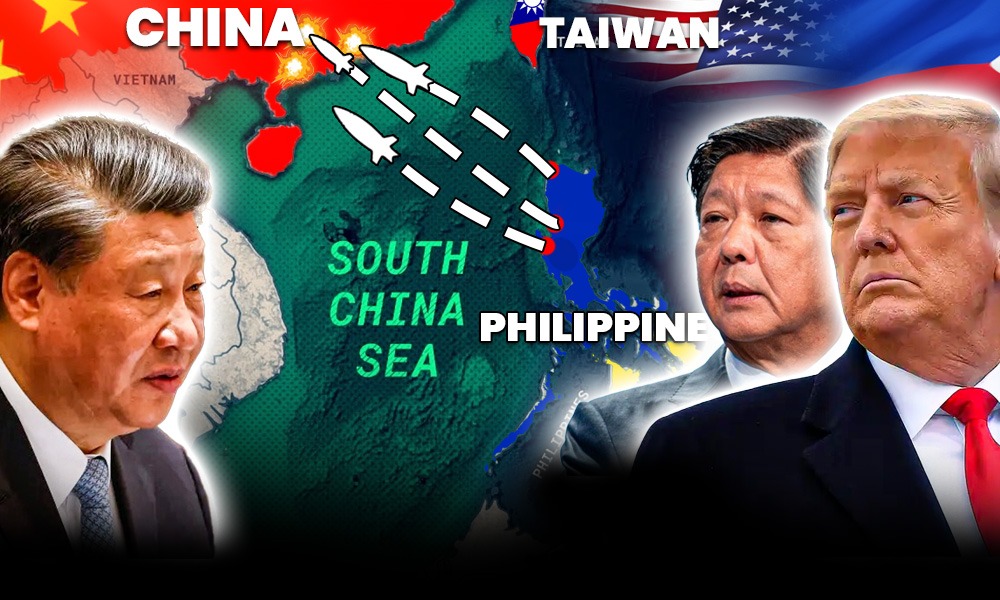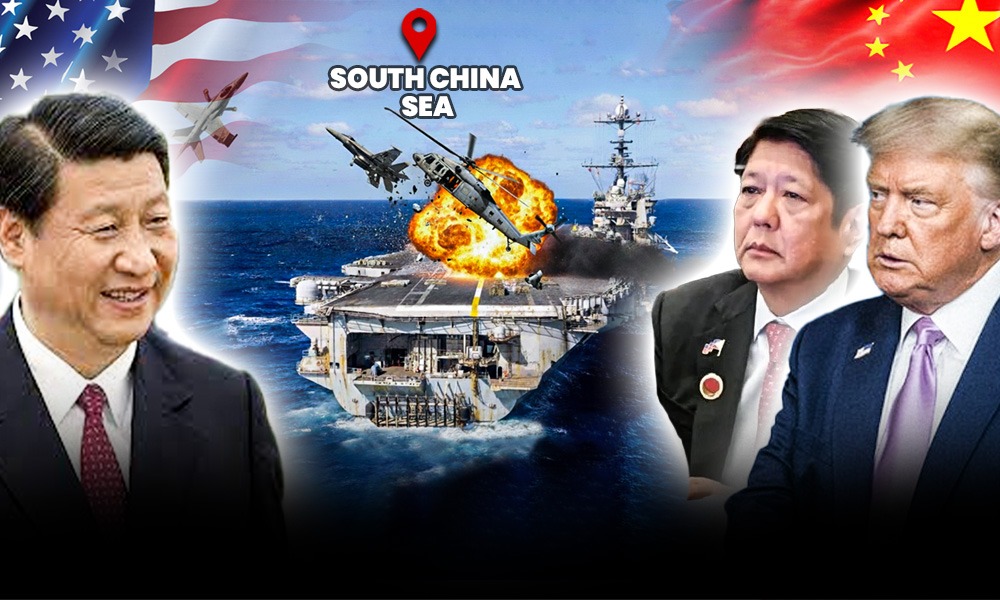Secret U.S. Naval Hub Near China’s Backyard Revealed! The South China Sea just got a lot more crowded and tense. The U.S. has quietly set up new naval logistics hubs in the Philippines, just 200 miles from Chinese-claimed waters, in a move aimed at countering Beijing’s growing aggression.
This isn’t your typical base. Think low-key but lethal, docks for fast patrol boats, drone-ready pads, radar systems, fuel depots. No flashy carriers. Just smart, mobile deterrence. As of July 2025, 4 new U.S.-backed sites are now operational under the Enhanced Defense Cooperation Agreement (EDCA), with at least two close enough to Taiwan to matter in a flash.
Why now? Simple. China is turning up the heat. Just in May, Chinese coast guard ships rammed or blocked Filipino resupply missions to disputed reefs 6 times. Loudspeakers blared: “This is Chinese territory. Leave immediately.”
But the Philippines isn’t backing down and neither is the U.S. “We’re not here to start a war,” said one U.S. Navy official, “but we’re not walking away either.” President Ferdinand Marcos Jr. is drawing closer to Washington, recently signing a defense pact with the U.S. and Japan, forming a new trilateral alliance aimed at keeping Beijing in check.
Behind all this is a region on edge. The South China Sea carries over $3.4 trillion in trade each year, and China claims almost all of it under its sweeping “Nine-Dash Line.” The world doesn’t recognize that claim but China keeps enforcing it with warships, artificial islands, and maritime militias. Locals are feeling the pressure. “We’re caught in the middle,” said a fisherman from Palawan. “But we won’t be bullied.”
What’s coming next? Experts say this could be a ‘mini Guam’ setup, designed for rapid response if things go south, fast. And with tensions flaring over Taiwan, 2025 might be the year when “silent deterrence” turns into direct confrontation. The U.S. is back in Southeast Asia, this time with smarter tools and stronger alliances. And China? It’s watching closely.
The New U.S. Boat Hub in the Philippines — Small Footprint, Big Message
In the quiet coastal town of Quezon, Palawan, far from the headlines but right at the edge of geopolitical tension, a new symbol of U.S.-Philippine military cooperation is rising, the U.S.-funded boat repair and maintenance hub. It’s not flashy. No fighter jets, no missile silos, no sprawling runways. But make no mistake, this small facility carries a big message.
Strategically located just 160 miles east of Second Thomas Shoal, one of the most volatile flashpoints in the South China Sea, the hub is part of a growing effort to prepare, not provoke. While it won’t house troops or launch operations, its value lies in what it enables: rapid response, increased maritime readiness, and local control.
This facility is built for speed and resilience. It’s designed to service the small, fast craft that make up the frontline fleet of the Philippine Navy, rigid-hulled inflatable boats, assault boats, and patrol vessels. These aren’t headline-making platforms, but they’re vital for asserting sovereignty, especially in contested waters regularly patrolled and often harassed by China’s coast guard and maritime militia.
Inside, the setup is compact but complete: repair bays for quick turnaround, secure storage for parts and supplies, and briefing rooms for mission coordination. Everything the Philippine forces need to stay operational in the face of mounting pressure is right there, built into one lean, efficient facility. And here’s the key, this isn’t a U.S. base. The funding comes from Washington, but the operation remains fully in Philippine hands. There’s no foreign flag flying overhead, no permanent American garrison. It’s a deliberate design, one that supports sovereignty while boosting capability.
A U.S. official described the facility as part of a broader strategy of “low-footprint deterrence”, supporting allies without overwhelming them, and reinforcing presence without escalating optics. In other words, help them stand stronger, but stay in the background.
In today’s South China Sea, where Chinese vessels swarm disputed reefs on a near-daily basis, and where the line between peacetime patrol and confrontation is razor-thin, this kind of infrastructure could make all the difference. It provides the tools to respond quickly, quietly, and effectively, turning a slow, vulnerable reaction into a swift, measured response. So while this hub might not make global headlines, it’s part of a much larger shift. A shift where the United States isn’t just watching from afar anymore, it’s positioning smarter, empowering allies, and preparing for whatever comes next.
Is Palawan a Real Powder Keg Between China and the Philippines?
U.S.-Philippine Military Alliance: From WWII Bases to 21st Century Deterrence
The U.S.-Philippine military alliance is one of the oldest and most resilient in the Indo-Pacific, a partnership forged in war, tested by politics, and now reshaped to meet the demands of a rising China. It began in the aftermath of World War II, when the United States, fresh off liberating the Philippines from Japanese occupation, signed the 1947 Military Bases Agreement. This allowed the U.S. to establish major military installations across the country, most notably Subic Bay Naval Base and Clark Air Base. These weren’t just outposts, they became some of the largest American bases outside the continental U.S., acting as a strategic springboard for U.S. power in Southeast Asia throughout the Cold War.
In 1951, the two nations signed the Mutual Defense Treaty (MDT), making it clear: if one country was attacked, the other would come to its defense. This treaty, still in force today, made the Philippines America’s oldest formal treaty ally in the Indo-Pacific. During the Cold War, the alliance held firm, and the bases played key roles during the Vietnam War and other regional crises.
But by the early 1990s, domestic pressures in the Philippines shifted the dynamic. A mix of nationalist sentiment, public protests, and a narrow Senate vote led to the closure of all U.S. military bases. Mount Pinatubo’s eruption in 1991, which devastated Clark Air Base, only sped up the withdrawal. By 1992, all U.S. forces were gone, for the first time in nearly a century. Even so, the Mutual Defense Treaty remained in place. The alliance didn’t dissolve, it simply went quiet.
Then came the 2010s. With China ramping up its island-building and maritime aggression in the South China Sea, the U.S. shifted its strategic focus back to Asia under President Obama’s “pivot to Asia.” In 2014, this renewed partnership was formalized through the Enhanced Defense Cooperation Agreement (EDCA).
EDCA wasn’t about bringing back old bases. It offered something more flexible, rotational access for U.S. forces, pre-positioned equipment, and infrastructure upgrades at Philippine military sites, all under Philippine control. No permanent U.S. presence. No sovereignty lost. But the message was clear: the alliance was back in action, adapted for the 21st century.
By 2025, nine EDCA sites have been activated, including critical locations in Palawan, Isabela, and Cagayan, many just a few hundred miles from Taiwan and the South China Sea flashpoints. These sites are now central to the U.S. strategy of distributed presence: small, mobile, and close to where tensions are highest.
Over 70 years since its inception, the U.S.-Philippine military alliance continues to evolve. From post-war bases to modern-day rapid deployment hubs, it has become a key pillar of regional security, not by returning to the past, but by adapting to the challenges of today.
The Numbers Behind the Tension: U.S. vs China in the South China Sea
The South China Sea isn’t just heating up, it’s already in a low-key arms race. Both the U.S. and China are flooding the region with ships, systems, and shadow operations. And the stats tell the story.
On the U.S. side, the military has gone all-in. In just one recent year, over 100 large-scale military exercises were conducted in and around the South China Sea. That’s about two every week, on average, from joint naval drills with allies to amphibious assault simulations and maritime patrols.
“We’re not trying to start a war,” said one U.S. Pacific Fleet officer. “But we are making sure everyone knows we’re ready.” Washington is also deploying next-gen systems to the Philippines: Marine Corps anti-ship missile launchers, long-range drones, and unmanned reconnaissance vessels, all part of a strategy built for fast strike and flexible defense.
The U.S. Navy’s muscle remains unmatched, carrier strike groups, nuclear submarines, and P-8A Poseidon patrol aircraft regularly operate across the Western Pacific. Meanwhile, a new wave of Foreign Military Financing is flowing to Manila, including a $500 million package to upgrade Philippine defense and interoperability.
But China’s presence? It’s constant. Near-daily patrols by Chinese navy, coast guard, and maritime militia vessels near reefs, shoals, and islands claimed by the Philippines have become the new normal. Filipino sailors report being blocked, trailed, or blasted with water cannons on routine missions.
Satellite imagery shows China’s military build-up is no bluff. In both the Spratly and Paracel Islands, Beijing has built up artificial islands, complete with airstrips, radar arrays, missile systems, and deep-water ports. These are not “research stations”, they’re fortresses on reefs.
Back in 2016, the Permanent Court of Arbitration in The Hague ruled against China’s sweeping “nine-dash line” claim, siding with the Philippines. But China flat-out rejected the ruling and has only tightened its grip since.
The result? A crowded, contested sea where every patrol, every flyover, every drill is part of a high-stakes geopolitical chess match. One wrong move, one misread signal and things could escalate fast.
What They’re Saying: Inside the Power Play of the South China Sea
Words can be just as powerful as warships and the key players in the South China Sea are making their positions crystal clear. From the U.S. side, the message is firm but diplomatic. In a recent statement, the U.S. Embassy in Manila emphasized the bigger picture: “This new facility reflects the shared commitment of our treaty alliance to maintain a free, open and resilient Indo-Pacific.” Behind the calm tone is a strategic nudge, aimed squarely at Beijing’s tightening grip over contested waters.
Another U.S. official put it more bluntly, noting that operations in the Philippines are now conducted in a “joint and combined manner with an ally directly confronting China.” No room for ambiguity, Washington is backing Manila, not just with money, but with muscle.
From the Philippines, the tone is sharper. General Romeo Brawner Jr., Chief of Staff of the Armed Forces, didn’t mince words, labeling China’s moves in the West Philippine Sea as “ICAD, illegal, coercive, aggressive, and deceptive.” It’s a diplomatic acronym with battlefield weight, a clear rebuke of Beijing’s maritime behavior.
Another Philippine defense official highlighted the long-term advantage of the partnership, saying the U.S. presence and assistance “enhances our capability in maritime domain awareness.” Translation: We see more, we know more, we’re not going blind into gray zone conflict anymore.
And then there’s Beijing. While staying silent on the latest U.S.-funded boat hub in Palawan, China’s stance hasn’t changed. State media has repeatedly accused Washington of “plotting with its allies to contain China’s rise.” That phrase, now a regular line in Beijing’s geopolitical playbook, reflects how seriously China views these “defensive” moves. With each side speaking its truth, in tones that range from diplomatic to defiant, the rhetoric is rising almost as fast as the patrol boats.
What It All Means
The new U.S.-funded boat hub in Palawan isn’t just a construction project, it’s a clear, calculated move in a bigger strategy: to reinforce the U.S.-Philippine alliance while keeping a low-footprint but high-impact deterrent against Chinese aggression in contested waters.
More than ever, this marks a shift in the South China Sea, from isolated patrols and reactive diplomacy to coordinated, tech-driven, allied defense planning. With each new facility, each joint exercise, and each unmanned system deployed, the region edges closer to a standoff where preparation, not provocation, becomes the language of power.
And beyond strategy and stats, this new hub tells a deeper story: of how old alliances are evolving, of how the Pacific’s balance of power is being reshaped in real time, and of how geopolitical history is never really over, it just adapts. The sea may look calm. But underneath, the game has changed.
200,000 Filipinos in Danger — What Happens If China Invades Taiwan?



